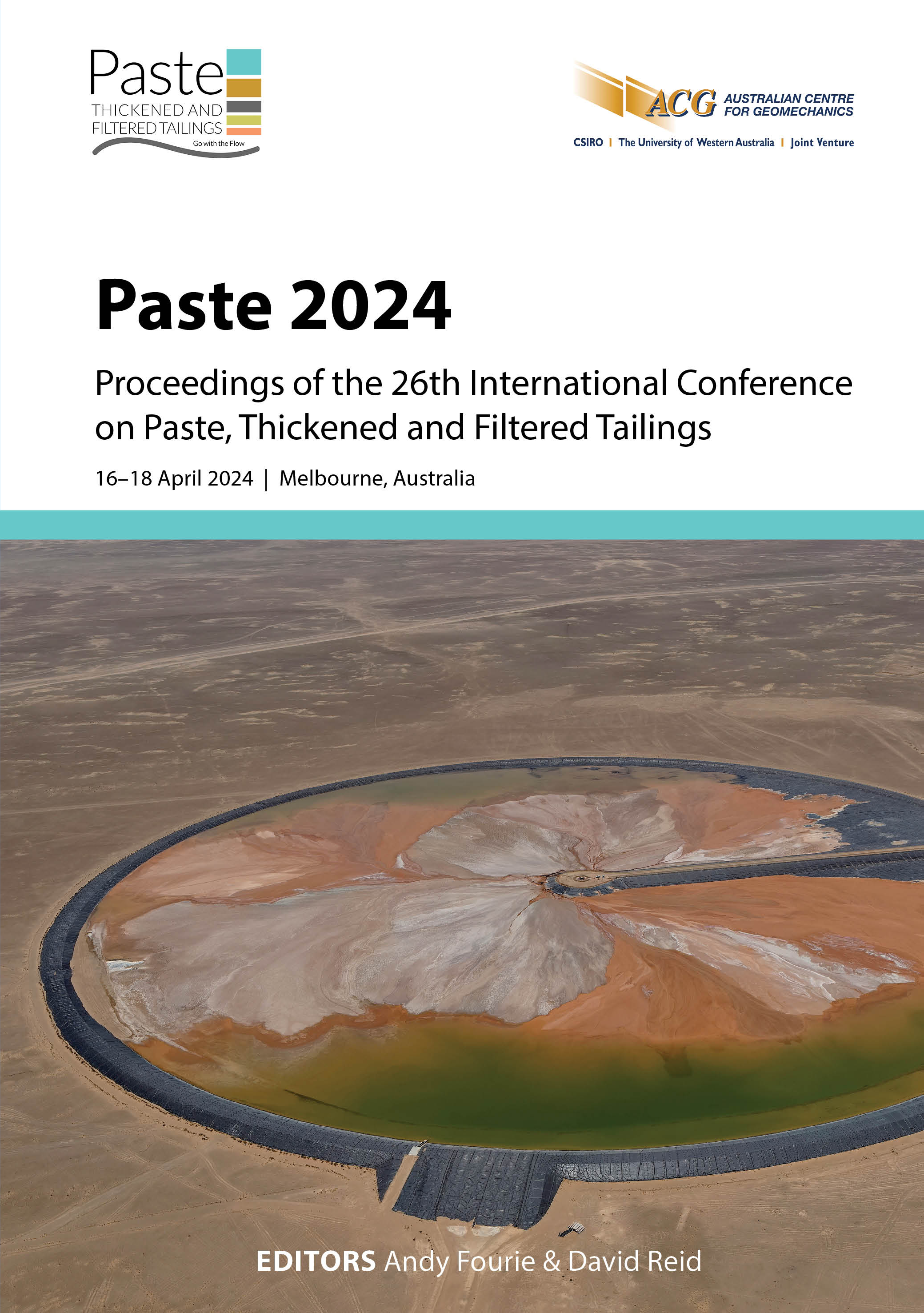Ultra paste and central thickened discharge: a paradigm shift in tailings management

|
Authors: Roshdieh, A; Seddon, K; Pirouz, B; Javadi Rudd, S; Williams, P |
DOI https://doi.org/10.36487/ACG_repo/2455_17
Cite As:
Roshdieh, A, Seddon, K, Pirouz, B, Javadi Rudd, S & Williams, P 2024, 'Ultra paste and central thickened discharge: a paradigm shift in tailings management', in AB Fourie & D Reid (eds), Paste 2024: Proceedings of the 26th International Conference on Paste, Thickened and Filtered Tailings, Australian Centre for Geomechanics, Perth, pp. 205-220, https://doi.org/10.36487/ACG_repo/2455_17
Abstract:
Tailings management remains a top priority for the mining industry, driven by the pursuit of safety, environmental sustainability and operational efficiency. The accumulation and subsequent loss of water in tailings storage facilities (TSFs) poses a significant challenge, leading to the growing popularity of schemes that reduce water content in tailings. One such scheme is central thickened discharge (CTD), where the slurry is discharged in the centre of the disposal area to create a low conical ‘hill’ of tailings. Retaining embankments are thus minimised. The beach slope formed by the deposited tailings plays a crucial role in its design. This slope depends on the discharge flow rate and slurry rheology, which, in turn, is influenced by the solids concentration and particle size distribution of the discharged tailings. This paper focuses on the concept of ultra paste (UP) – a novel approach that utilises a combination of thickening and filtration to achieve a higher solids concentration in the slurry. The objective is to maintain a pumpable and self-distributing slurry at the TSF, but be capable of depositing at a steeper beach slope than achievable through thickening alone. By exploring the development and components of UP, this paper highlights its potential advantages compared to other non-conventional methods like filtration and paste systems. Furthermore, the paper addresses the potential risks associated with UP and proposes comprehensive strategies for risk mitigation. A case study is presented to compare three schemes – paste, UP, and filter stack based on cost, water conservation and risk management. This comparative analysis provides insights into the potential benefits and limitations of each scheme, demonstrating how UP has the potential to widen the range of topographic conditions suitable for thickened tailings discharge. In conclusion, the application of combined UP and CTD represents a paradigm shift in tailings management, offering a balance between solids concentration, pumpability and deposition slope. By understanding the advantages and risks associated with UP and CTD, mining industry stakeholders can make informed decisions to enhance their tailings management practices, contributing to safer and more sustainable mining operations. The adoption of this innovative approach has the potential to increase the available options for tailings management and contribute to the advancement of environmentally responsible mining operations.
Keywords: tailings management, central thickened discharge, ultra paste
References:
Jewell, RJ & Fourie, AB 2015, Paste and Thickened Tailings – A Guide, 3rd edn, Australian Centre for Geomechanics, Perth, p. 12.
Krimpenfort , H 2018, ‘A comparison between various pump systems for high flow rate tailings pipelines’, in RJ Jewell & AB Fourie (eds), Paste 2018: Proceedings of the 21st International Seminar on Paste and Thickened Tailings, Australian Centre for Geomechanics, Perth, pp. 155–168,
Roshdieh, A, Seddon, KD, Pavissich, C 2016, ‘Optimization of tailings management scheme: comparison of tailings filtration and paste’, in S Barrera & RJ Jewell (eds), Proceedings of the 19th International Seminar on Paste and Thickened Tailings, Gecamin, Santiago, pp. 170–180.
Roshdieh, A, Javadi, S, Williams, MPA & Karamad, E 2021, ‘Mixing requirement for ultra paste tailings’, in AB Fourie & D Reid (eds), Paste 2021: Proceedings of the 24th International Conference on Paste, Thickened and Filtered Tailings, Australian Centre for Geomechanics, Perth, pp. 59–70,
Seddon, KD, Pirouz, B & Fitton, TG 2015, ‘Stochastic beach profile modelling’, in R Jewell & AB Fourie (eds), Paste 2015: Proceedings of the 18th International Seminar on Paste and Thickened Tailings, Australian Centre for Geomechanics, Perth, pp. 455–465,
Williams, MPA, Seddon, KD & Fitton, TG 2008, ‘Surface disposal of paste and thickened tailings — a brief history and current confronting issues’, in R Jewell, AB Fourie, P Slatter & A Paterson (eds), Paste 2008: Proceedings of the Eleventh International Seminar on Paste and Thickened Tailings, Australian Centre for Geomechanics, Perth, pp. 143–164,
© Copyright 2025, Australian Centre for Geomechanics (ACG), The University of Western Australia. All rights reserved.
View copyright/legal information
Please direct any queries or error reports to repository-acg@uwa.edu.au
View copyright/legal information
Please direct any queries or error reports to repository-acg@uwa.edu.au
